Black Rock Country Club
MA, USA
Green Keeper: Chuck Welch
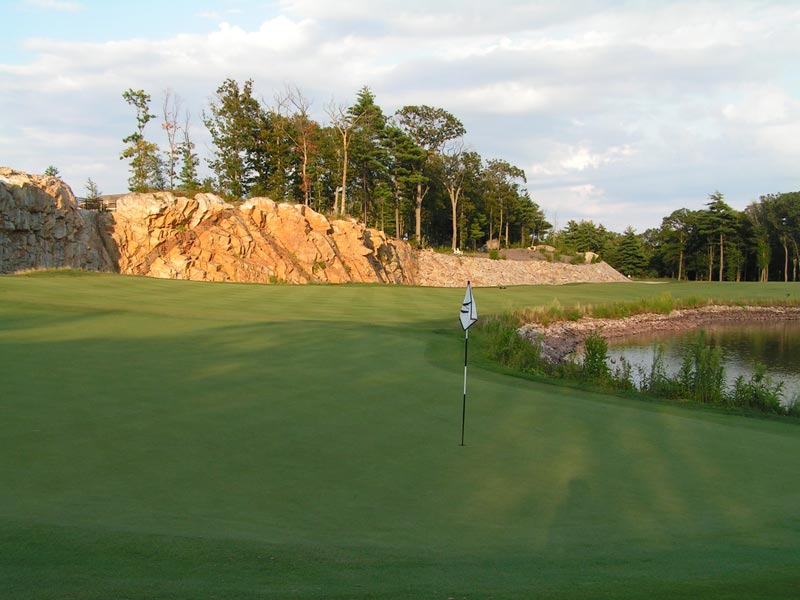
Black Rock Country Club enjoys a tranquil and beautiful setting for a game that is hard to imagine given that it is situated within a rock quarry that was active as recently as 1998.
Owners like their prospective architect(s) to tour the property once and swiftly proclaim it ideally suited to golf and that a world top one hundred course can be built here. Architects happily oblige, uttering the time honored cliche that ‘God intended this to be a great course.’
Happily, such a song and dance never occurred at Black Rock. The owners knew they had a parcel of land not necessarily suited for golf but alas, it was the only large contiguous parcel they could find along the golf hungry south shore of Boston. The architect they selected, famous for his quick wit, couldn’t have said much on his first tour as half the property was an active gravel quarry with literally no dirt. Yet, in the end, the owners got a series of holes that range from good to great with not a dull one among them (thus far exceeding the owners’ hopes), the architect privately considers it the best project he has worked on, and the fortunate members get to play a course rife with fun and enticing shots.
The story begins in 1992 when George McGoldrick moved to the south shore. Though he loved the area, a key attribute was missing and that was the ability to play a golf course nearby. The private clubs had a ten year plus waiting list, leaving McGoldrick and his friends little option but to drive for an hour just for the opportunity of playing a five hour round at a crowded public course.
As a developer, McGoldrick appreciated that the high end demographics of those around the greater Hingham area thirty minutes south of Boston supported a golf course. The rub was where to find a block of land big enough for both a course and real estate component. McGoldrick became aware of a 200 acre rock quarry that recently traded hands and was presently owned by Jim Read. Of course, a rock quarry presented all kinds of construction challenges but it did have one benefit: other parcels of land around it were available for sale as no person or business voluntarily elects to locate beside an active rock quarry!
McGoldrick and Read decided to partner and established Black Rock Developments in January, 1999 for the sake of building the course and homes. They acquired the various parcels of land around the quarry, which totaled an additional 250 acres.
The next step was to select the architect. The design fees proffered by several of the biggest name architects frankly seemed of poor value to McGoldrick. Instead, he thought of the courses built in recent times around the greater Boston area that impressed him as being fun and two readily came to mind: Waverly Oaks and Cape Cod National. Brian Silva designed them both so McGoldrick invited Silva to tour their 400 plus acres.
The quarry was still active in the winter of 1999 with many of the rock land forms extreme to the point where one had to wonder if a course should even be built here, much less one that would render holes of good golf quality. Blasting and disposal of huge boulders too big for the crusher would be a major task during construction. In addition, wetlands were scattered throughout. Nonetheless, after several months of walking the property in the dead of winter, a routing emerged. According to Silva, the process was like a jigsaw puzzle, as follows:
At Black Rock, I knew we wanted to work with the rock faces that came to line the 7th and 16th holes. With a proposed clubhouse location at the edge of the rock crushing plant, a number of golf holes would fill this large open area. I was pretty sure of the “corridors” for 1 and 10 and there were endpoints – wetlands – that defined how long these holes would play. On one side of 1 and 10, there was a hole-width corridor that would form the second half of the 18th hole. And there would be another hole corridor or two that were bounded by 1 and 10 on one side and a road on the other. Past that road, there was room for a golf hole that would be bounded by a wetland on its other side. The landforms on this hole – to be #4 would not allow two individual golf holes. A par four worked up to a huge ledge but a less than 100 yard par three could be jammed from the other side of the ledge to a proposed road. The hole had to be a par five but how could a five be built without an excruciating amount of blasting – well, how about a punch bowl? And with those early-on thoughts driving the routing, maybe the blanks can be filled in.
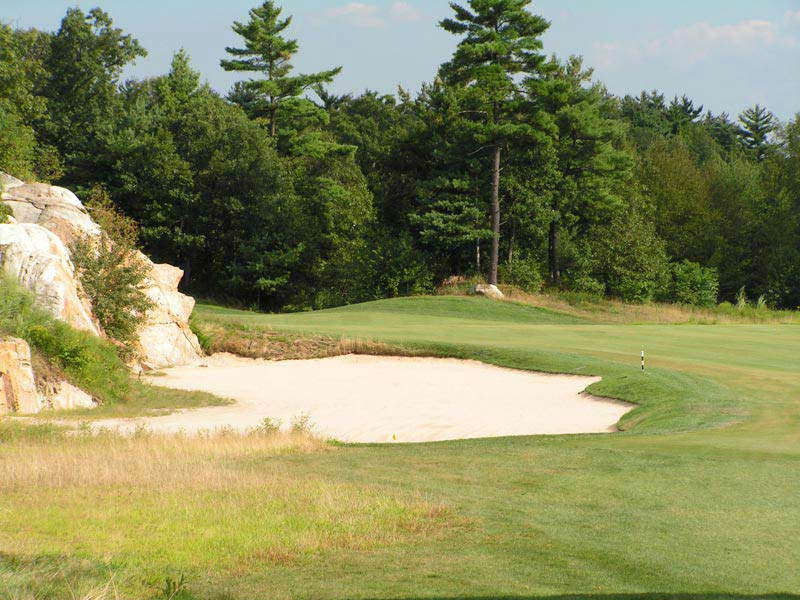
The rock wall down the length of the 7th was integral in helping Silva develop an initial routing.
Hole #1 is set as per above. Cross the wetlands behind the green and there is a nice downhill setting framed left and rear by ledge – #2 is a par three.

The one shot second plays across a natural valley – any shot just short of the putting surface likely takes the slope and rolls downhill, well away from the green.
Can’t do much behind #2 as there is a road and then you are off the property. There is a development parcel to the rear and right of 2 tee – so let’s run #3 along another property line – turn right from #2 green and head up into a cove formed by large boulders.The tee shot for #3 is over a wetland and is solid rock all the way past that to the green – hopefully the Reads can blast the top four or five feet off of the ledge to make something that better resembles a fairway – with the proposed green framed to the rear by wetlands. That’s the third hole.There is an uncomfortable tie-down on the left side of the hole where ledge drops right off to nothing – maybe a strip bunker would do a good job of helping to tie together this disparate grades. And there is an awesome quick “up” to the green – “foxy” – #3 is set. Cross the wetlands behind the green and you soon come to another property line. The resulting corridor can’t be two holes because of the huge ledge outcrop noted earlier. This outcrop has to be made into something golf-able and the land past the outcrop falls precipitously away. What fits there? The punchbowl idea means 4 is set.
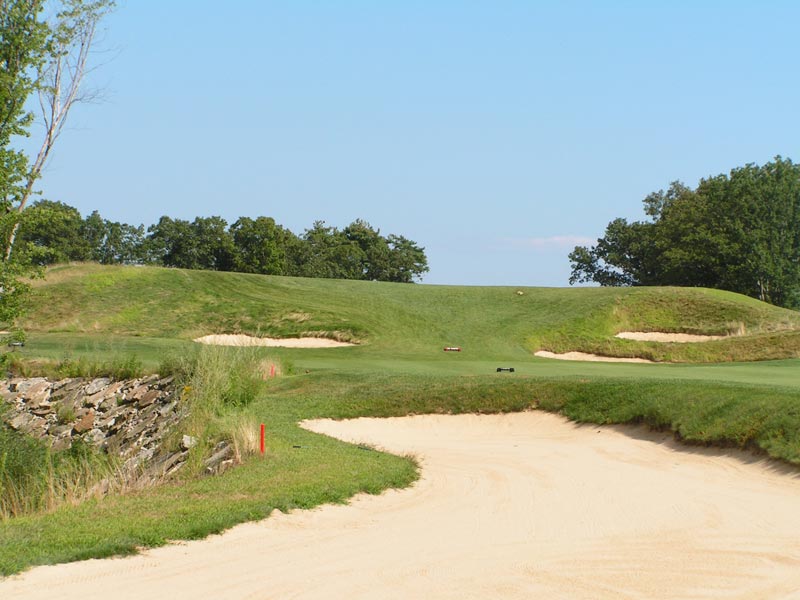
The ideal second shot at the fourth is a thrilling one that must scale a 40 foot rock ledge.
5 and 6 turn out to be the two holes on the “other side” of one and ten with five playing slightly uphill all the way to a green pad that is a 30 foot high setting of old pipe, cement beams, rebar and all kinds of other construction debris. Another aspect of Black Rock’s history becomes apparent – a dump site for decades of construction debris. But the landing area is framed by an awesome oak – one of the few specimen trees to be found on the site.
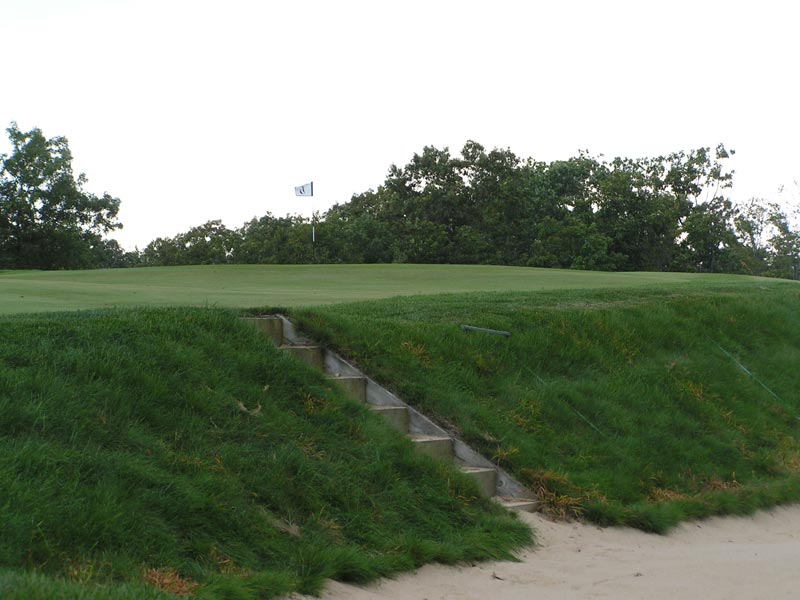
A beautiful horizon green can be found at the 5th – what’s underneath the green is a different matter!
Pepe’s hole – a large rock quarry that encompasses parts of three holes and was used as another dump site for construction and quarry debris – could be made into something on #6. On either side of Pepe’s hole – named for the guy who worked it – are nice plateaus. Hopefully the road behind the tee area on this corridor can be shifted back so that a good drive comes to rest near the edge of this first plateau. If this works, the second plateau on the other side of Pepe’s hole works as a swell second landing area. And players have to work point to point (plateau to plateau) to keep a good view of this golf hole.
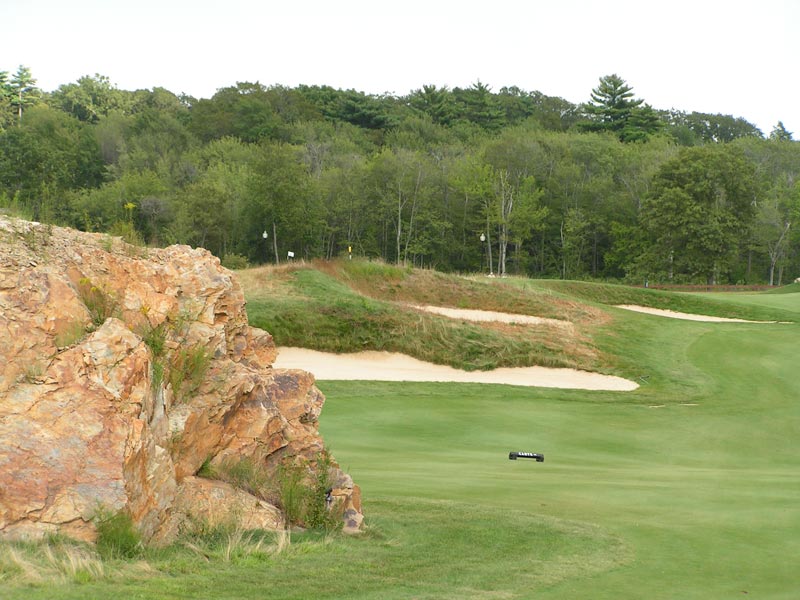
The fairway at the 6th today rolls along nicely. However, when Silva first walked the property, the place marked by the cart sign in the photograph above was actually fifty feet (!) lower. By using the 6th fairway as one of the primary areas for the disposal of boulders, Silva created a hole natural in appearance that is full of playing interest.
Cross a wetland to #7 tees. 7 works around a rock face. The green is in one of the few gravel pit areas remaining on the course (the Black Rock lineage is that areas were mined for gravel and once they were stripped to solid rock, the area became a blast area for rock that went into the crushing plant). Let’s keep the spent gravel pit look on the left side of this hole from the landing area to the green. There is a great green plateau for 8 but no landing area at all – a fifty foot tall ledge outcrop runs between the tees and the green. It’s gotta go. Back across the wetland to #9. The tees have always been set, framed on one side by wetland and to the rear and right by the entrance road. The hole is originally routed as a right to left par three that plays along a wetland but is “changed” a number of times due to road and development parcel concerns to a sharply uphill par three. It’s a nice par three along the wetland in the low green location and a poor hole in the high green location. Ya, the low location works out. 10 is already set and has a blasted ledge outcrop that frames the green.

Brian Silva escapes from the back greenside bunker at the 10th. The rock behind the green coupled with the wetland area to its left provided Silva with definite end points for the 10th green site.
I know where 12 is going – there is a great ledge boulder cove for the green setting – so 11 has to connect 10 to 12 and this hole works through rock outcrops to the landing zone set on a plateau that looks down to the green.
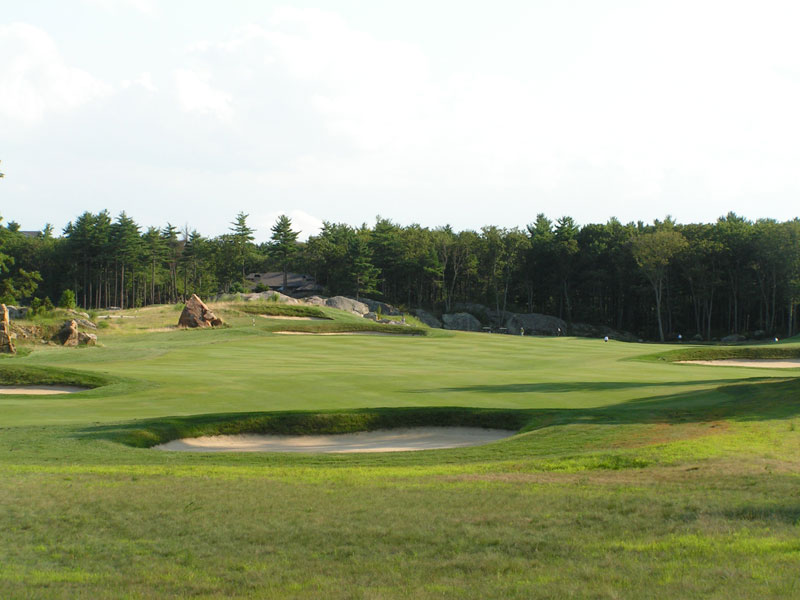
The beautiful view from the 11th tee.
12 is good stuff. Tees that were supposed to be on top of huge rock boulders get nestled in between rocks – much better than where I had them located originally.
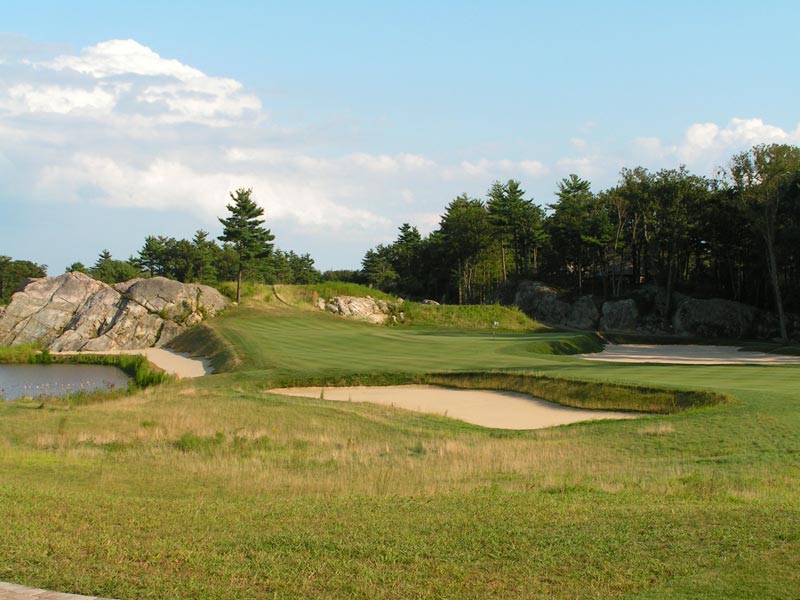
The great long one shot 12th where the golfer can use the ground left of the green to feed his tee ball onto the putting surface.
13 is simply ledge with no fairway to be found. There’s a great location for tees up on top of the rocks that frame 12 green but the rest of the hole will be a blast-o-rama! And it somehow works out to be a unique drive-able par four.

The course at Black Rock enjoys a sense of spaciousness but the going gets tighter at the reachable, 335 yard 13th hole.
14 plays over some nice land – pretty gentle grades up to the landing area and then back down gently to the green. Not too much rock though there are outcrops right of the drive zone and left of the second landing area that will do a nice job of supporting bunkers.
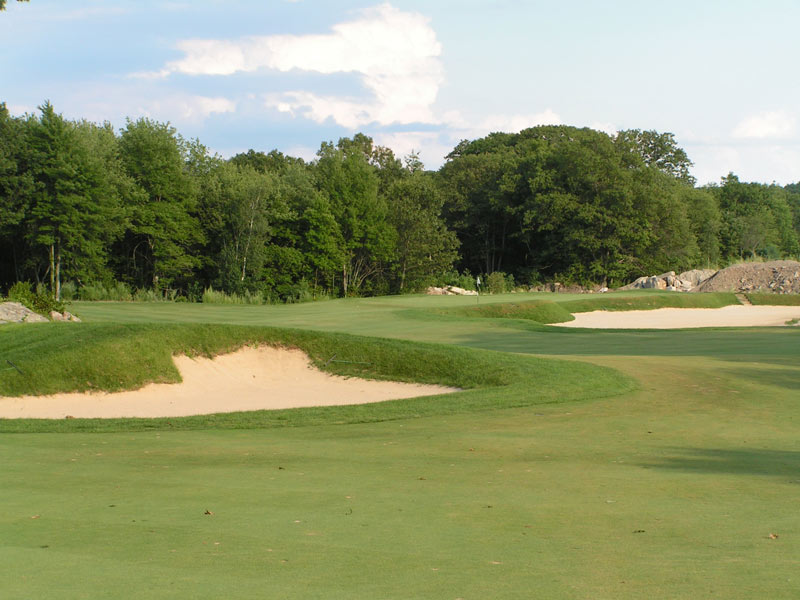
The three shot 14th flows over some of the gentler land on the course. Speaking of gentler, note the rounder, softer shoulders of the bunkers versus those at Silva’s Black Creek.
15 is a flattish area that has been de-flattened by being used as a dumps site. With the debris removed, it will be a good distance for a bit of a breather par three before the long road in.
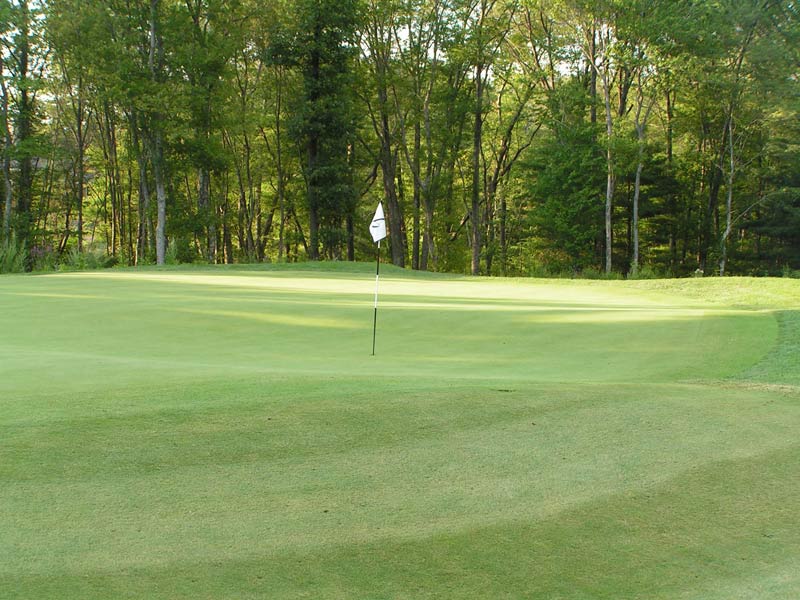
The bath tub feature within the 15th green helps make the hole distinctive.
16 takes its line all the way from an old blasted ledge face.17 is going to have a road through it……no, it is going to be a housing area……no, it will just be a golf hole!!! And there is lots of width with which to have some landing area fun. I’d like a fade green here but the existing ledge pond doesn’t work for fade – let’s make it a hook as 18 is fade all the way (and in hindsight so is a good portion of the back so the existing pond helped me out!)18 may be the plainest land on the property – where the old crushing plant was set up. Once the plant is gone and all its flotsam and jetsam is removed – huge piles of rock too large to fit in the crusher and huger piles of processed and washed stone – the hole is a dogleg right with no inside feature. How about a bit of a bunker?

The 18th hole finishes in front of the clubhouse. The playing corridors of what became the 6th, 1st, 10th, and 18th holes where in a large open 400 yard area wide that suggested itself early on to Silva as the ideal place for the clubhouse with holes radiating out from it.
Finally there are 18 holes on paper.And in the best situation – and I had the best situation at Black Rock – there is a guy like George McGoldrick who sticks with you. Without that, the majority of the paper holes have no chance of becoming golf holes on a site like this. And it keeps going along – some holes fit land in a good way – 7, 16, 2, 9, 12, 14, 15 – while others are what the hell can be done to make this a golf hole! I need as good a client as I can ever find to make it work type of golf holes. Some holes jump at you off the background map – some you recognize walking the land – some finally become golf holes about five minutes before you seed them.
Black Rock was not, obviously, “there were 120 great golf holes on this property and I just had to narrow it down to the best 18”. It was more like “there might be 6 to 8 golf holes on this property – how are we going to round out the field?” At the very worst – some corridors you have “selected” appear to have no natural potential as golf holes – the big architect upstairs had no intention of them being golf holes. They are 8, 13 and 17, among others. They will have to be built. At the worst – some corridors you have selected appear to have no chance of becoming golf holes as their previous use created a complete lack of potential. They are 1, 6, 10, 15 and 18. They will have to be “cleaned” – and where does one dispose – on a site that has been stripped to bedrock – of hundreds upon hundreds of thousands of yards of ledge too large to fit in a crushing plant and more construction debris than you have ever seen in total on all of your jobs? It is a big jig saw puzzle…in planning and construction…..something you don’t see on the site on Monday makes itself apparent later in the week. Something that you think will never work – #13 – is a world’s fair view from the tee in more than one direction and turns out to be a sharp golf hole. On some holes you know what you want to do…on others you have a general leaning and on still others you are stunned at what appears after clearing/debris disposal and wonder what a thirteen hole golf course will do for your handicap if not your career. Something that you think would work easily has to be worked over and over til you wear out the dirt. It is a jig saw puzzle.
With the routing complete,the way forward is now known. The monstrous task of building the course from such an unpromising beginning as a gravel quarry commences. The challenges are numerous and occur on an almost daily basis. Finding soil and clay is one of the biggest but the timing is fortuitous as there are several huge building projects going on around Boston at this time including one at M.I.T. These projects are looking to rid themselves of the dirt and clay and Black Rock gladly strikes a deal with them.
A crucial addition occurs early inconstruction and that is when Chuck Welch is brought on board as Green Keeper. Silva worked with him in Maine and knew of his ability to grow grass in less than ideal (e.g. rocky with severe winters) situations. As at Silva’s highly successful Black Creek in Chattanooga, Silva provides several ‘kick boards’ for golfers to use in banking balls onto greens at Black Rock. In addition, short grass plays a key role around the greens. Thus,much of the fun and strategy of playing Black Rock hinges on firm and fast playing conditions, attributes that Chuck Welch and his crew have continually delivered since the course opened in July 4th, 2002. Examples of the optimal playing conditions found at Black Rock are citied below.
Holes to Note
Third hole, 400 yards; A perfect example of how not to bunker a green. Presently, raters of various golf magazines appear fixated regarding the look of bunkers, seemingly more so than their placement. Bunkers with ragged edges are the rage as they are deemed ‘natural’ in appearance. With attractive bunkers being highly prized, there appears to be an absence of thought given as to when not to bunker a green complex. The 3rd hole at Black Rock is made by Silva’s lack of greenside bunkering. In lieu of eye-catching bunkers cut into the hillside, the golfer is confronted with seemingly nothing other than the tight grass leading up to (or is that away from?) the green. After just a round or two, the golfer appreciates that the playing characteristics of the short grass coupled with the narrow shelf green is far more vexing than any bunker(s) could be.
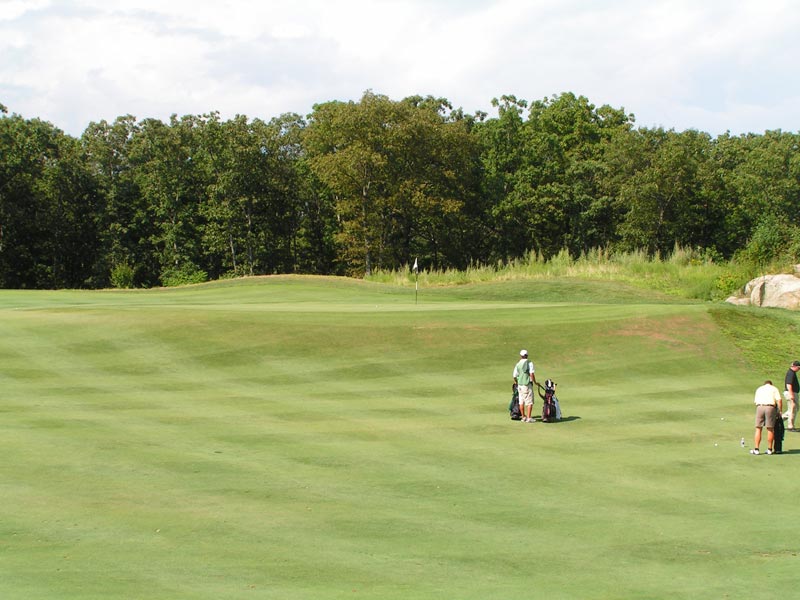
The great shelf green at the 3rd - the ball closest to the green was once three feet from landing and staying on the putting surface. Now the golfer must make sure he makes no worse than a bogey as a weak chip sees the ball return to his feet.
Fourth hole, 565 yards; Aptly named the Green Monster, the architect, the owners, and the Green Keeper should be congratulated for this hole. First, the architect for even conceiving the hole to begin with and for not having the ridge destroyed during construction. The owner deserves lots of credit for grasping how much fun this hole could play, despite its unconventional nature. And finally, the Green Keeper and his crew for maintaining the 12,000 square foot punch bowl green, the crucial attribute in allowing the hole to play so well.
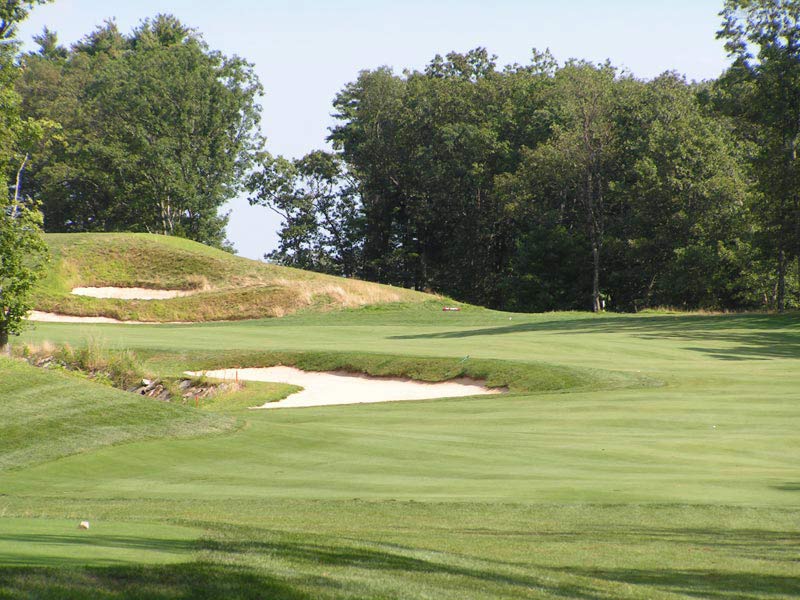
The three shot 4th swings to the left after the tee ball. Ideally, one's second shot carries over the forty foot ledge from where it is downhill the last 95 yards to...

...an enormous gathering green. Though blind, the second shot is thrilling with golfers scampering to the top of the ridge to see if their well struck second shot found its way close to the green and perhaps the hole.
Sixth hole, 585 yards; Silva rightly contends that the weakest shot on most courses is the second shot on the par five holes. In short, most golfers are given little to think about or do other than advance the ball a couple of hundred yards ahead. This is emphatically not the case at Black Rock, as seen at the 4th and again here at the 6th. A fine drive rewards the golfer with a good view of the next plateau that he ideally seeks with his second shot. From there, a crisp pitch to the green slightly below might set the golfer up for a ‘4’. Such smooth sailing is set up by the drive. If the drive is weak or indifferent, the view for one’s second shot becomes materially worse. In fact, a bunker that is centrally located in the fairway 150 yards from the green now becomes blind and preys on the golfer’s mind.
Seventh hole, 385 yards; Some great short two shotters like the 9th at Harbour Town require an accurate drive in order to set up the approach shot at the horseshoe green. Accuracy is a pre-requisite on both the tee ball and the approach shot, which seems ‘fair’ on a sub 400 yard hole. Still, there are lots of ways to require such accuracy. Harbour Town does it with tall pine trees pinching in the fairway sixty yards shy of the green. Another, more subtle way is to give the golfer plenty of fairway as a target off the tee. However, because of the angle of the green, the golfer eventually realizes after a few rounds that there is an exact area in the fairway that sets up the ideal approach. Such is the case here at the 7th where the course’s narrowest green at only 16 paces wide points back to the left center of the fairway. Bunkered both left and right, the golfer wants to pitch to this green down its center line.

The 7th green at Black Rock is a tiny target with sand both left...
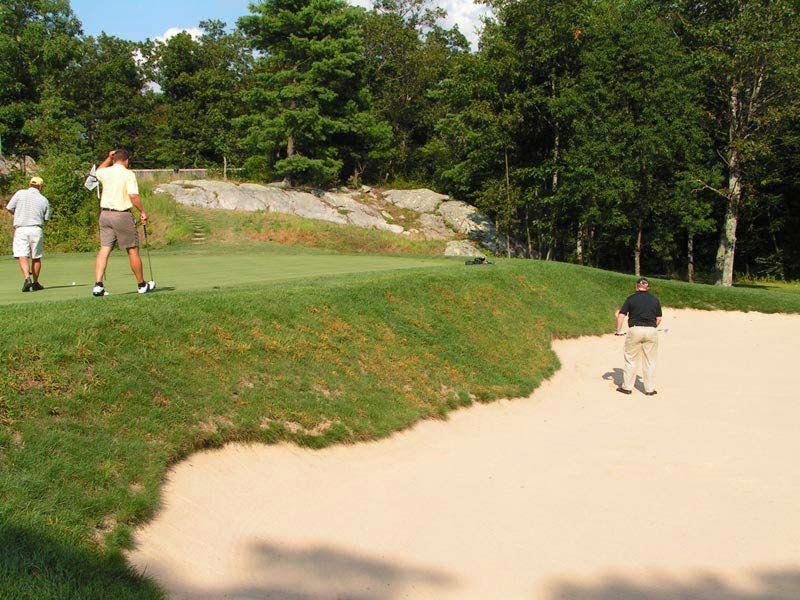
...and right of this narrow green. More than one golfer has, sadly, visited both bunkers during the round.
Ninth hole, 175 yards; All the best playing characteristics of a Redan are present here with a green that slopes from high front right to lower back left. There are so many fun ways to play this hole that one wonders why other modern architects aren’t as keen in adapting this classic designelement into some of their own designs. Ever since Silva became involved in restoring Seth Raynor’s very fine design at Lookout Mountain in 1999, his own work such as Cape Cod National and Waverly Oaks have regularly featured this Redan playing characteristic, a good thing.
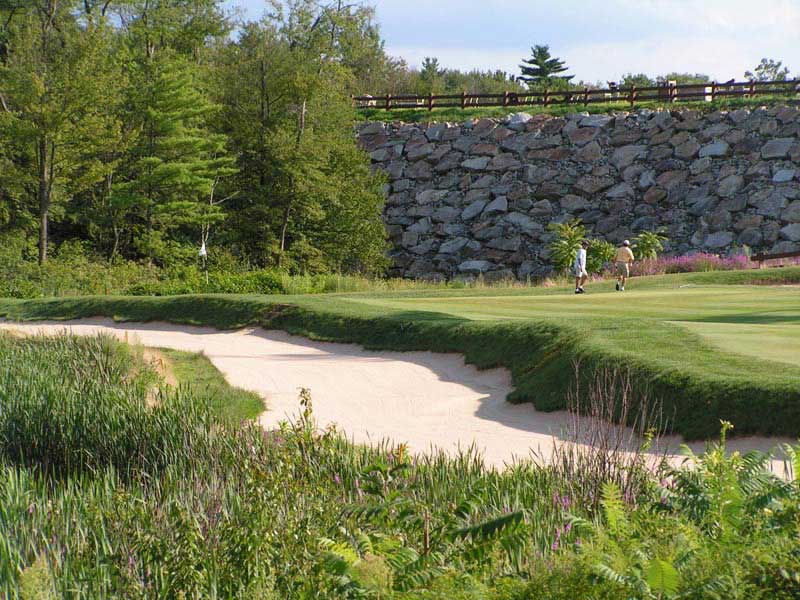
The back left hole location appears tough but a draw in the direction of the two golfers leaving the green will find one's ball taking the slope of the land and feeding back toward the hole.
Eleventh hole, 415 yards; According to Brian Silva’s own description of how the routing evolved at Black Rock, the 11th was a connector hole. He had the definite end pointof the 10th green site and the 12th was a natural. The success of the design at Black Rock is just how well the connector holes like the 3rd, here at the 11th, and the 17th turned out. In this case, the green complex makes the hole. The 32 yard long green is high in the front for the first 13 yards, lower in the middle, and highest in its back third. Ala the famous 16th at North Berwick, the green is canted at an angle to a tee ball hit down the middle. Though the green is open in front and along its right side, some of the deepest greenside bunkers on the course are found left and behind this green.

The 11th green is set at an angle to the center line of the fairway.
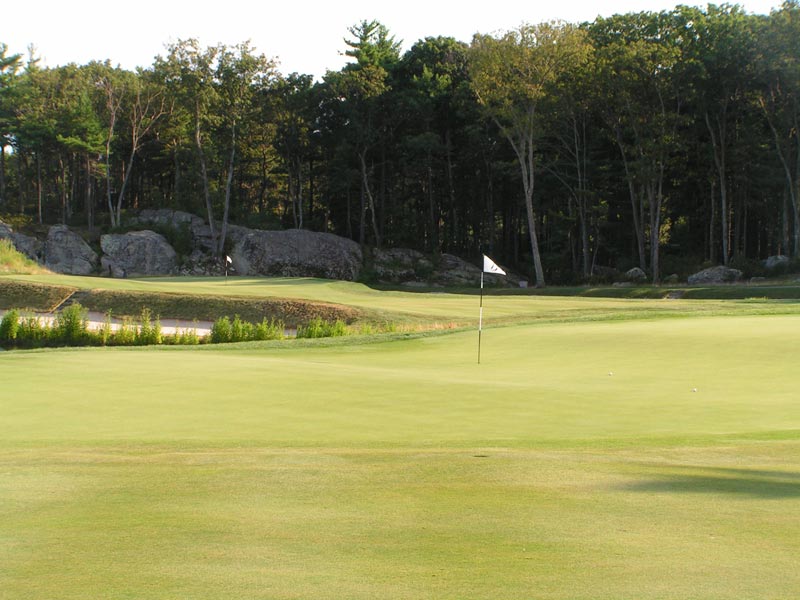
The attractive putting surface at the 11th seems open and inviting...
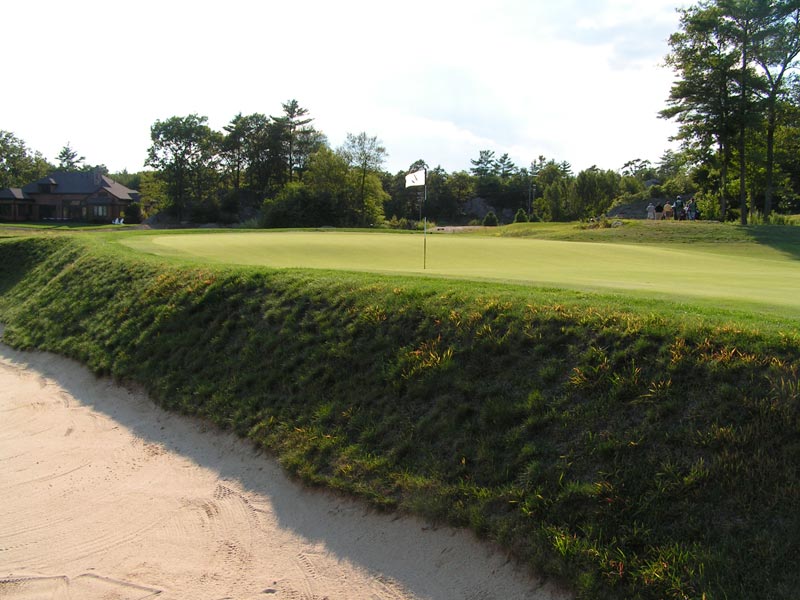
...yet a slight tug and one's approach is likely to find this hidden bunker.
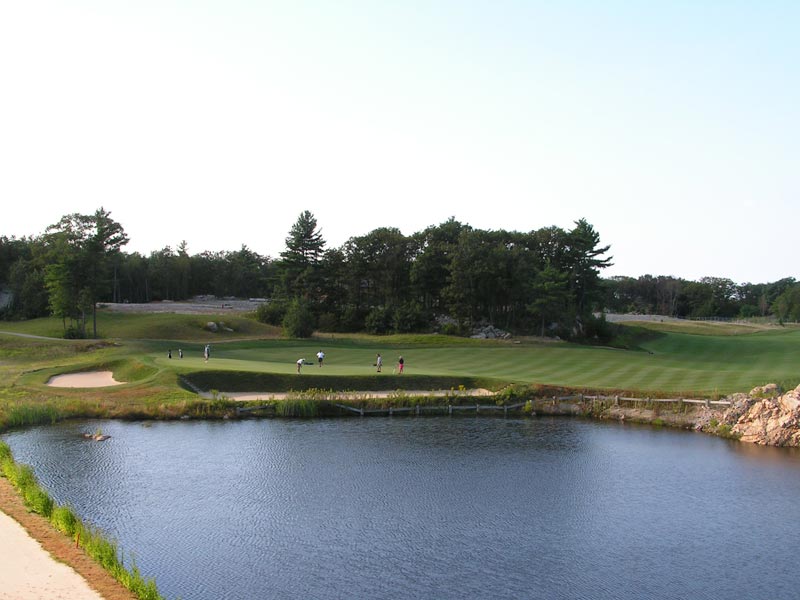
This view back down the 11th hole shows how well defended the green actually is.
Twelfth hole, 225 yards; Spectacular in appearance, the golfer soaks in the view from the elevated tee. Well in the distance is the green with a 50 yard long bunker along its right side. Though the scale of the bunker dominates the eye, the area of real interest should be the tightly mown short grass on the left to right slope along the left of the green. The ‘real’ – certainly the fun – shot is to hit a low ball toward that slope and watch the ball feed onto the green.
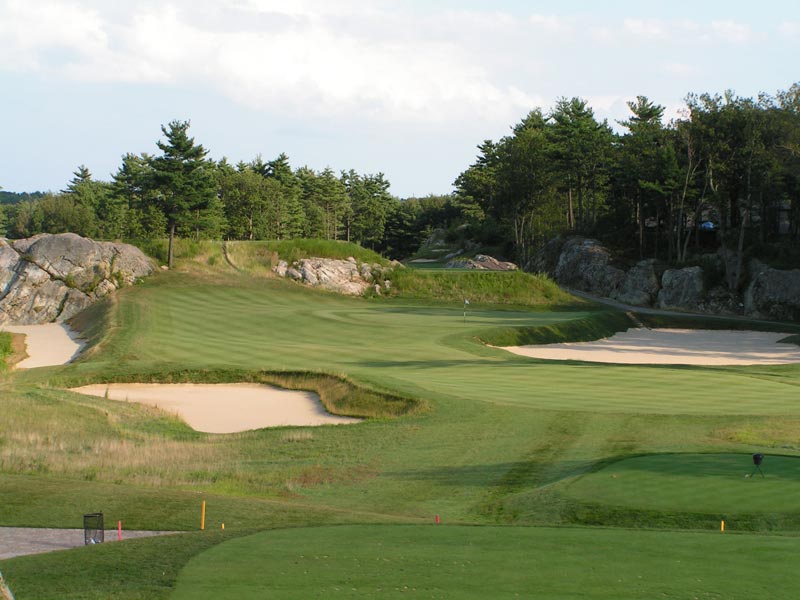
Though the eye may drift to the right at the greenside bunker, the play is left off the bank.
Thirteenth hole, 335 yards; In a show of how well run Black Rock is, the 13th is played slightly forward at many of the club events. The golfer is goaded from the elevated tee to having a ‘go’ for the green approximately 300 yards in the distance. And that is when the fun begins. An interesting attribute of the hole is that the fairway is widest sixty yards from the green and narrowest one hundred yards from the green. Golfers that gear down off the tee andelect to hit a controlled iron two hundred yards are actually trying to hit the most narrow portion of the fairway. Silva acknowledges that he is messing with the golfer – and loves it!
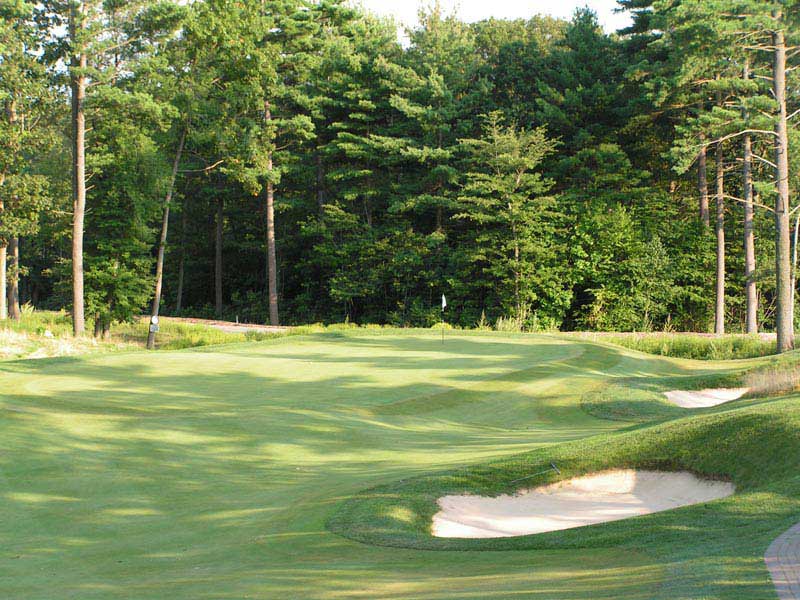
The 13th green is the second smallest on the course, behind the 7th.
Sixteenth hole, 460 yards; Brian Silva once remarked to the author in Bandon, Oregon how highly he regarded Pete Dye’s switchback holes. By that, he meant how Dye asked a golfer to shape a tee ball one way followed by an approach shaped the other. The 16th at Black Rock is a superb example of that very design principle. A long fade around the left to right bend of the fifty foot rock face places the golfer in the ideal position to approach this green. However, a right to left running approach is the preferred shape approach shot as it affords the golfer the opportunity a) to stay well away from the pond on the left and b) to take advantage of pronounced back to front slope that rings this green. As much as it pains the author to admit, he witnessed Silva himself hit the ideal fade tee ball followed by a low running draw for his approach. Silva’s approach took the high ridge around the back of the green, continued running, and eventually feed to within fifteen feet of the very tough back left hole location. This is yet another fine example of Green Keeper Chuck Welch and his crew maximizing the design/playing attributes of Black Rock.
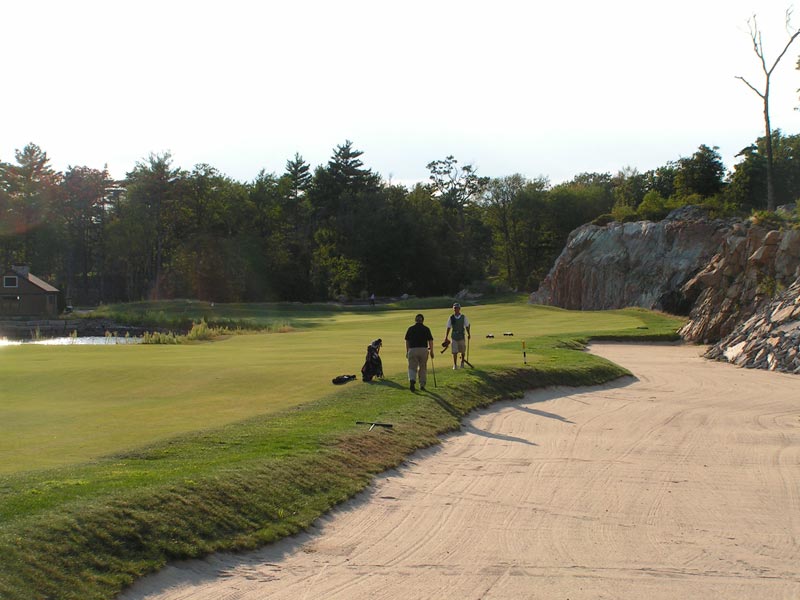
A fade around the bend at the 16th sets the golfer up for a draw to the green complex below.
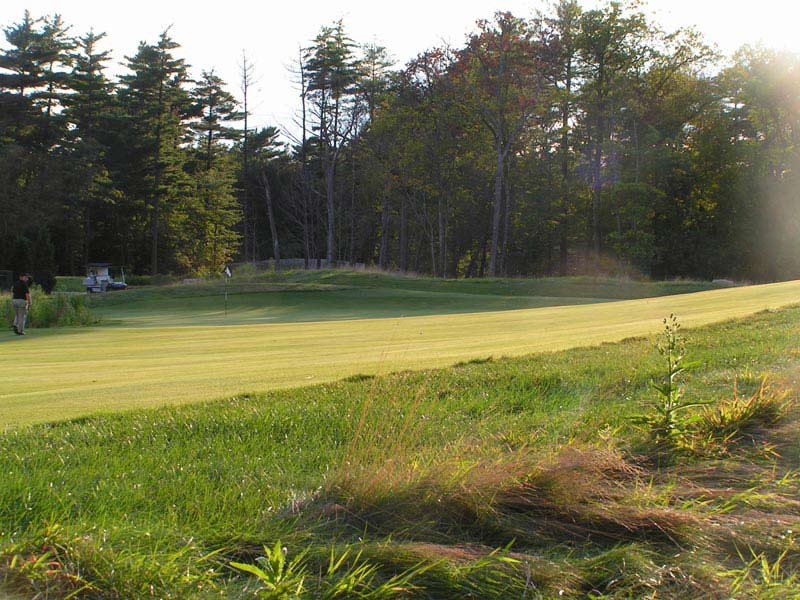
Silva's superb final grading would be for naught at the 16th without Chuck Welch and his crew providing the firm and fast conditions that allows golfer to properly utilize this slope.
Seventeenth hole, 420 yards; Creating interest and playing angles on straight holes was a lost art form from the 1950s though the mid 1980s. The noted architects of the time placed bunkers in the rough left and right off the tee, essentially calling for little decision making on the tee. Central bunkers were ignored in this period of architecture, and one of the primary design lessons available from The Old Course at St. Andrews went ignored. Mercifully, there has been a return in golf design to putting bunkers in the direct line of play where they might a) create confusion/uncertainty as to the best playing tactic and b) dictate strategy. The 17th features six bunkers in the tee ball hitting area, effectively creating a left and right fairway. The right fairway, which is more tightly defended,is preferable as the green is canted from front right to back left. The members – and that is who the course is built for – get to enjoy a hole with many different playing angles, a fact that insures that the hole never becomes monotonous to play.
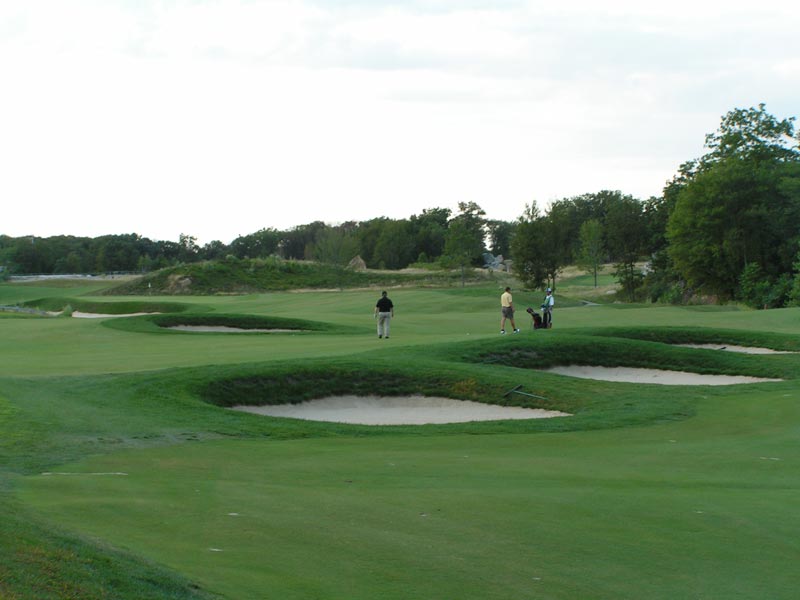
The luxury of having width to work with at the 17th allowed Silva the opportunity to create a split fairway.
There are many ways to marvel at Black Rock. First, for the owners and architect who had the vision and belief of what a rock quarry could become. Second, as a construction and engineering marvel. If one was unfamiliar with the history of the property, one might think Silva was given an idyllic piece of New England property – rolling with rock outcrops – with which to work. Nothing could be further from the truth. Third, as a work of art as from a harsh beginning, a thing of lasting beauty has emerged. And finally, and most importantly, as a great place to enjoy a game of golf with one engaging hole after another.
The End

